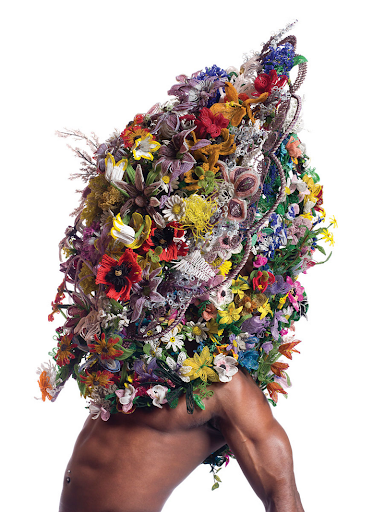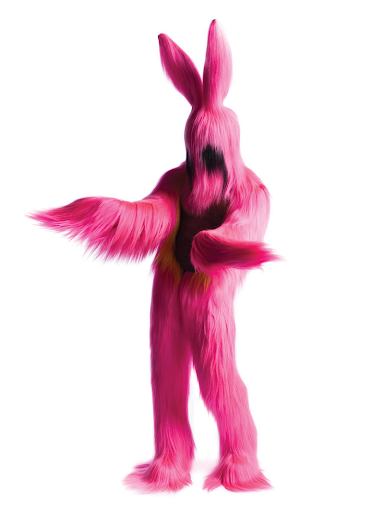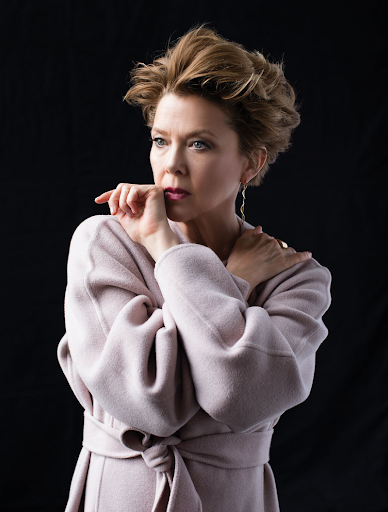ART
ARTIST NICK CAVE ON HIS LATEST INSTALLATION THAT’S PART CONFESSION AND PART DANCE PARTY
PHOTOGRAPY
by JAMES PRINZ AND COURTESY OF THE ARTIST AND JACK SHAINMAN GALLERY, NEW YORK
INTERVIEW
by TATIJANA SHOAN
WEB EDIT
by JEENA SHARMA
Immediately upon entering The Park Armory Drill Hall I felt as though I had taken a time capsule back to the 90s New York City club days, but without the drugs. Dancers moved around the space gyrating to the music in big, expressive, movements. Revelers dressed in their best bling, while many came decorated in creative, hand-made costumes. As I moved through the crowd, I started to feel as though the room was spinning as two gigantic mylar streamer curtains hypnotically snaked their way through the space while their multicolored tentacles washed over everyone as if we were cars in a car wash disco. A colossal game of Twister was being played in one corner, while hula hoops were being twirled in another. I couldn’t help but dance. I was in artist Nick Cave’s art exhibition, The Let Go.
Chicago-based artist Nick Cave doesn’t just make art, he creates spectacles, glorious happenings, where sculptural costumes, namely his Soundsuits, bend, bounce, flounce, flutter, and flirt for enchanted viewers. Installations that can, and have, fit into a space as large as a football field, are transformed into otherworldly destinations where crystal balls, crocheted tea cozies, and reclaimed racist objects live in harmony. Cave does more than make us happy: he makes us think. The objects and materials he uses are not random, but have a larger meaning, a social significance, and are meant to fuel our curiosity, diplomacy, and our understanding of our place in society and how we view ourselves and each other. His work is inspired by racial injustice—his first Soundsuit was a response to the Rodney King beating— and his resulting message is a colorful one of unification, transformation, equality, and harmony.
I had the fortunate opportunity to talk with Nick Cave while he was busy preparing for The Let Go in New York. We spoke about the light and dark sides of his artistic message, the importance of reclaiming racist objects, implicating the audience in his work, and what it’s like to wear his infamous Soundsuits.
AS IF: Your work has so much joy, it’s effervescent, there’s explosions of color and texture, yet your work comes from very sad places like social injustice, racism, inequality, gun violence, police violence. Did your process start with the light or the dark?
Nick Cave: My practice always starts with the dark, that’s the instigator that gets me fired up. From what is going on currently, politically, and personally, there is always an instigator that moves the activity in the studio. Personally, I am all color on the outside, internally I’m a very sensitive human being that is very concerned about the well-being of the country and my community. So, how do I take oil and water and find a way in which they can work hand and hand? That’s how I approach the work. The façade of my work is my seduction and a way for viewers to enter the work, but once you enter and start to break it down you begin to understand that there’s a much darker side and deeper meaning.
You want to bring your message to people in need, to people who are hurting, to people who need it, to people who are marginalized and don’t have a voice. How do you reach the unreachable, and how do you affect those that think art isn’t for them?
I tend to work outside boundaries. I run around the outskirts of cities and in inner cities to find young people to incorporate into a project, and I also work with a city’s educational programs. It’s never just about my project, I’m more interested in being of service. The most important thing for me is how to create a space of possibility, to bring young people into the fold and have them to stand within the space, look around, and know things are possible.

NIck Cave. Portrait by Tatijana Shoan.
You once described yourself as a messenger who brings people together to heal them through art. We’re certainly a fractured nation and in a world in desperate need of healing. Where do you see your bandages being applied going forward?
Being an artist was easy, but that’s not why I’m here, I’m a messenger first and foremost; so knowing that has allowed me to build my work around civic responsibility and humanitarian efforts. It’s the foundation of my existence.
Tell me about The Let Go that just happened at Park Avenue Armory in New York. I attended The Let Go Ball, it was amazing!
The Let Go is an amazing project; it unfolds daily and is a community-based project. You know, a part of me wants to create my own dance company and travel around the country, but a much larger part of me is drawn back to bringing projects to cities and hiring people in the city to build the project because that is connected to my purpose. The Let Go involved about 150 performers from dancers to musicians, and we hosted a number of events at Park Avenue Armory. The Let Go came about as I was thinking about the drill hall, which then led me to think about the town halls that were happening around the country, and that transformed into the idea of a dance hall. What I was interested in was the way in which we’re communicating and engaging with one another, it’s become so harsh and so destructive, and I thought, what is another way that I can bring us together in a harmless environment and activity? And that was how I thought about dance. We all have our differences, we can all be on the dance floor and work it out through movement. It’s safe, it’s an invitation for anyone to participate, it can unify us. Within The Let Go and living within the Park Armory is an object titled Chase which consists of two 40ft by 100ft mylar streamer curtains that are moving throughout the entire drill hall. You coexist in the space and you find yourself moving in, with, and around it. The object is designed where the streamer is red, black, and green, followed by blue, black, blue, black, representing the African flag and the colors of a police uniform. It symbolizes black men being chased by the police, so there is this dark, political undertone, yet the space allows us to work in harmony.

Up Right performance at The Let Go, 2018, The Park Avenue Armory, NY. © Nick Cave. Courtesy of the artist and Jack Shainman Gallery, New York.
In your Mass MoCA show, Until, you used black lawn jockeys and I want to ask about reclaiming racist objects. Can their meaning be transformed? Why not just abolish them altogether?
I would like to literally demolish all racist artifacts out there. What was interesting about the Mass MOCA project and the reason I used the lawn jockeys, is that Trayvon Martin had recently been killed, and Eric Garner was choked to death by police in Staten Island for selling cigarettes, and keep in mind that my first Sound Suit was in response to the Rodney King beating, so I’m spinning out of fucking control thinking what is going on?? I was in my studio working one day and I thought, is there racism in heaven? I then created this crystal cloud scene, levied the cloud up high, and created a forbidden garden with black lawn jockeys that were holding dream catchers. That was my interpretation and response to the question, is there racism in heaven?
You elevated their meaning.
Yes. I’m interested in negotiating how we view them, how we respond to them.
I can’t believe you don’t draw or sketch! Your work is so intricate and complicated.
But the intricacies comes from the foundation of knowing how to construct and build things, which I know how to do. In knowing that, understanding how things need to be fabricated, and knowing who I need to work with to help facilitate all the moving parts is part of my practice.

Installation view, Nick Cave. Until, MASS MoCA, North Adams, MA, October 15, 2016 – September 4, 2017. © Nick Cave. Courtesy of the artist and Jack Shainman Gallery, New York.
“I was in my studio working one day and I thought, is there racism in heaven? I then created this crystal cloud scene, levied the cloud up high, and created a forbidden garden with black lawn jockeys that were holding dream catchers. That was my interpretation and response to the question, is there racism in heaven?”
You once said about your Soundsuit, it’s a transformative experience for the wearer when the suit comes on. I would imagine as the viewer that it would be hard not to feel the emotion emanating from the person in the Sound Suit.
With the Soundsuit, the wearer needs to settle into it, that’s the first and most important factor: you must settle down and be open to the transformation that’s going to happen. You have to get yourself ready for your identity to transform. And, what that feels like for me is going to be different for you, and that’s all based on who you are as an individual. The wearer hides gender, race, class, and thus you’re liberated because you are not inhibited by identifying who you are, and you start to move into the role of conviction, and what that means to you. What does that look like? Where are your boundaries and limitations within a Soundsuit? It’s very therapeutic and demands a lot of the wearer, but at the same time when you’re with a group of 30 and collectively moving together it’s quite remarkable because you become one, you become a collective, you become a tribe and you stand with pride, you stand with power, you stand in power. The physical demands are extremely challenging as well, but it’s all about an internal understanding of yourself and allowing yourself to go to places you’ve never gone to before.
Your work is in motion, I see it as emotion in motion, and you place importance on turning your viewers into participants or as you once said, implicating them in the art. How do you reconcile with the gallery and museum static field where the visitors are coming as observers and keep a safe distance from the art? How do you get your message across when a Soundsuit is immobile?
When I was growing up, particularly in undergrad school, I would go to the Museum of Natural History and look at amazing artifacts. I would think about how all these garments and vestments had a purpose. In museums you are forced to look at them as sacred objects, and I was very interested in the duality of that, how this static object had a role where it functioned within a particular society. I was also interested in the performative side of what I would see. When my Soundsuits are not worn they are secured on two-wheeler carts where they become sculptural objects, which will later be transformed into a Soundsuit. I like their static state, and the static implications allow you to imagine them in motion, imagine what they sound like, and that’s just as interesting as when they are in motion.
I am interested in one of the titles from your last shows, Made by Whites for Whites. Tell me about the show and the significance of the title.
The idea for Made by Whites for Whites came about during one of my many visits to antique stores and flea markets looking for resources for my work. During one road trip I happened to come across a container with a removeable black man’s head on it. I then proceeded to read the inscription which said, “The Tomb”, and I literally flipped out! I then started to look for the most repressive, obscene objects and imagery of people of color. So, these artifacts became the center of that exhibition. But, what I was interested in was how these objects made the black man identify our place within society, and that’s how that title, Made by Whites for Whites, came about.

Nick Cave, Soundsuit, 2009. Mixed media © Nick Cave. Courtesy of the artist and Jack Shainman Gallery, New York.

Nick Cave, Soundsuit, 2010, mixed media including synthetic hair, fabric, and metal
96 x 29 x 20 inches ©Nick Cave. Courtesy of the artist and Jack Shainman Gallery, New York.

Nick Cave, Soundsuit, 2011, mixed media including dogwood twigs, wire, basket, upholstery, metal, and mannequin
87 x 27 x 35 inches © Nick Cave. Courtesy of the artist and Jack Shainman Gallery, New York.
With social justice and social awareness being your main artistic mission, how has this presidency affected you?
Oh honey, well that’s how I created The Let Go. In this presidency, I’m trying to ask myself how can I be of service? Can I create experiences that provide a common ground, and a place where we can collectively come together to be a vehicle for change? But for me, I don’t want to do something directly in response to it because it becomes categorized with a lot of other things. I’m more interested in how I can think about this state of urgency and create experiences that provide a sense of optimism, a moment of reflection that refuels us. In my classroom, I’m thinking more about ideas of collaboration where students come together around a particular theme. It’s about trying to be part of a force that’s keeping us together and giving people voices and platforms to share their points of view.
Does your work with the students at The Art Institute of Chicago inform your work and studio practice? Or, is it more of a sharing relationship where you’re there to give?
It’s a bit of both. These students keep me very much alive, they keep me relevant because of the expectation they have on me to bring solutions, clarity, and advice. I love the fact that each student comes at the work from a different place, a different approach, and they keep me on my toes. I have to find ways to bring in understanding. They think what I do is glamorous, but they also understand the enormous level of commitment to the practice. When we do study trips, I take them to meet designers in the industry, artists in the industry, decorators, professional shoppers, curators, and museum directors. What I’m trying to show them is that not all of them are going to be artists, but there are many extraordinary pathways to establish themselves in extraordinary careers in the arts. You know, this doesn’t come easy, it doesn’t matter if you come from a place of entitlement honey, in the creative hustle you don’t get a handout.
You were quoted as saying, we live in exhausting times and I’m in need of a savior. How does your own spirituality inform this view, and who or what is your savior?
One day while in the studio I came to an understanding that I was a messenger first, and an artist second. I have no real religious beliefs, but I do feel a higher energy, and I understand that I am free. I was telling my friend the other day that I’m not dependent on the art world for survival, it’s not why I’m here, but I do understand that it’s given me a vehicle to express and deliver deeds before I move on to the next assignment. I’m grateful for these beliefs.

Nick Cave, Soundsuit, 2016, Mixed media including various toys, wire, metal and mannequin
84 x 45 x 40 inches. © Nick Cave. Courtesy of the artist and Jack Shainman Gallery, New York.
“In this presidency, I’m trying to ask myself how can I be of service? Can I create experiences that provide a common ground, and a place where we can collectively come together to be a vehicle for change?”

Nick Cave, Speak Louder, 2011. Mixed media, including black mother of pearl buttons, embroidery floss, upholstery, metal armature, and mannequins. Installed: 93 1/2 x 199 x 123 inches
Individual suits: 84 x 32 x 15 inches, 83 1/2 x 33 x 14 inches, 84 1/2 x 33 x 18 inches, 93 1/2 x 33
© Nick Cave. Courtesy of the artist and Jack Shainman Gallery, New York










MORE FROM AS IF

© 2018, AS IF MEDIA GROUP
ALL RIGHTS RESERVED
AS IF MAGAZINE
ABOUT
CONTACT
NEWSLETTER
PRIVACY POLICY
TERMS OF USE
SITE MAP
SUBSCRIPTION
SUBSCRIBE
CUSTOMER SERVICE
SEND A GIFT
SHOP
PRESS CENTER
ADVERTISING
IN THE PRESS
GET IN TOUCH
FOLLOW US
YOUTUBE




